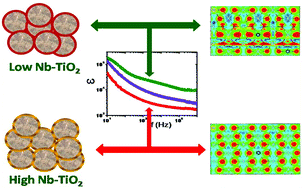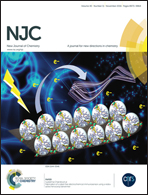Enhancement of dielectric constant in a niobium doped titania system: an experimental and theoretical study†
Abstract
Gigantic enhancement of relative dielectric permittivity of TiO2 upon doping with niobium is reported here. Dielectric and impedance spectroscopic analysis on these materials indicates a electrically heterogeneous microstructure consisting of semiconducting grains and insulating grain boundaries, leading to formation of numerous micro-capacitors, within the single phase compound. However, the degree of electrical heterogeneity decreases with increase in Nb5+ doping concentration as the Nb5+ starts to get segregated at the grain boundary. In addition to extrinsic electrical heterogeneity, intrinsic defect dipoles also contribute towards the large permittivity. Experimental observation has been rationalized at atomic level using density functional theory (DFT) which reveals that Nb atoms do not favor closer positioning and that the thermodynamically preferable distance between two dopant atoms (Nb atoms) is ∼7 Å. Remarkably at this distance the system becomes highly polarized due to occurrence of Ti3+/Nb5+ defects in nearby regions, which in turn leads to a colossal dielectric constant.


 Please wait while we load your content...
Please wait while we load your content...